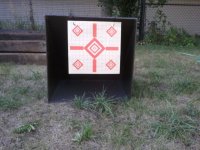One of my regular partners was a bit "frugal", and casted his own bullets from reclaimed projectiles and wheel weights. He got tired of sifting through the sand berme at the range, so we built him a large, stationary trap like you have described. It didn't look quite the same, but it stopped everything from the full gamit of handgun & rimfire rounds to the jacketed centerfire rifles we threw at it. Sorry I don't have a photo, and I've left that town far behind.
Local State DOT provided us with lots of worn cutting edges from their plow blades, all in sections about three feet long, eight inches wide, and about 3/4" thick. Not sure what alloy they are, but they were "abrasion resistant" steel, same as steel targets and commercial traps are made from.
We spent some time straightening the less-than-ideal edges, with a couple 7" grinders. Preheated so as not to loose the temper, we welded together three six foot by two foot panels, with angle iron flanges on the back surface. That way, it was kinda' modular, and we bolted it all together in-place. Each panel we moved made us wonder why we didn't make them eight inches wide. Made two triangular panels, by welding a 6x4' rectangle, then cutting it diagonally. Burned holes in the right-angle of both triangles, welded flanges on the outside of them too.
After finding a couple virile dupes to help us, we went to the range and put it all together with Grade 8 bolts. Ran a length of threaded rod across the triangles (bottom-front), and "viola"... a very stout four foot high, six foot wide ultra-heavy duty bullet trap that stood up to everything the club members fired at it.
The ground in/below was about six inches of sand, but you never had to dig deeper than +/- half an inch. No holes, dents, or even dimples in the steel. The threaded rod was shot through by the end of the first season, but it was heavy enough that nothing moved, anyway. Spoke with my old partner on the phone last month, and he's still collecting the lead from the same trap, and all he's ever done is applied an occassional coat of spray paint to reduce rusting. That's over twenty three years of durability, with almost daily use.

